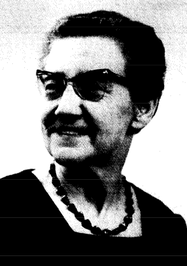 Engineer of the Week No. 41: Alice Christine Stickland BSc, PhD (16 March 1906- 16 April 1987) Today, on the 22nd anniversary of her death we remember Christine Stickland, radio, radar and astrophysics engineer. Christine Stickland was an applied mathematician with interests in radio, the development of radar and electromagnetic radiations. Born in Camberwell, her father was a publisher’s clerk so it is not clear where she found her inspiration to take up maths, physics and technical subjects. She may well have not considered herself to have been an engineer, but the range of work she undertook included a lot of practical applied physics, which is so close to engineering as to make no difference. Like many women of her era, her 1927 mathematics degree, from King’s College London led her into the scientific civil service where she was initially one of those who checked calculations, later progressing to being a research assistant. In the pre-war period she was at an Assistant Grade II in Dept of Scientific and Industrial Research, at the Radio Research Station (RRS) at Ditton Park, and worked with some of the best known names of that time: she assisted radar pioneer, R. A. Watson-Watt, on long-wave propagation, R. L. Smith-Rose on short-wave propagation, and E. A. (later Sir Edward) Appleton on the properties of the ionosphere. Whilst still working at the RRS she studied privately for an MSc in 1929 and then a PhD on ‘The Propagation of the Magnetic Field of the Electron Magnetic Wave along the Ground and in the Lower Atmosphere’ in 1943. In 1940 she and her co-author, JS Petrie, won the IEE Wireless Section Premium for their paper on ‘Reflection curves and propagation characteristics of radio waves along the earth’s surface’. She was a prolific writer of papers and books. Dr Stickland was elected a Fellow of the Physical Society in1942, and from 1947 to 1960, she served as the Secretary and Editor of the Physical Society, then becomingthe Editor and Deputy Secretary of the (combined) Institute of Physics and Physical Society. After her ‘retirement’ in 1968 she continued to do editorial work, including as the Managing (General) Editor of the Annals of the International Years of the Quiet Sun (1964-65), working with very distinguished scientists, then going on to work with the International Council for Science’s Committee on Space Research (COSPAR). In her private life she was a great supporter of the Girl Guides’ Association, and is believed to have been a Commissioner. She was remembered by colleagues for her gentle personality, but firmness of mind and conscientious efficiency.
0 Comments
Leave a Reply. |
- Home
- Electric Dreams
- All Electric House, Bristol
- Top 100 Women
- Engineer of the Week
- The Women
- Timeline
- WES History
- EAW
- Teatowels For Sale
- 50 Women in Engineering
- Museum Trails
- Waterloo Bridge
- History Links
- Blue Plaques
- Virtual Blue Plaques
- Career and Inspiration Links
- Contact
- Outreach
- Photo Gallery
- Bluestockings and Ladders
